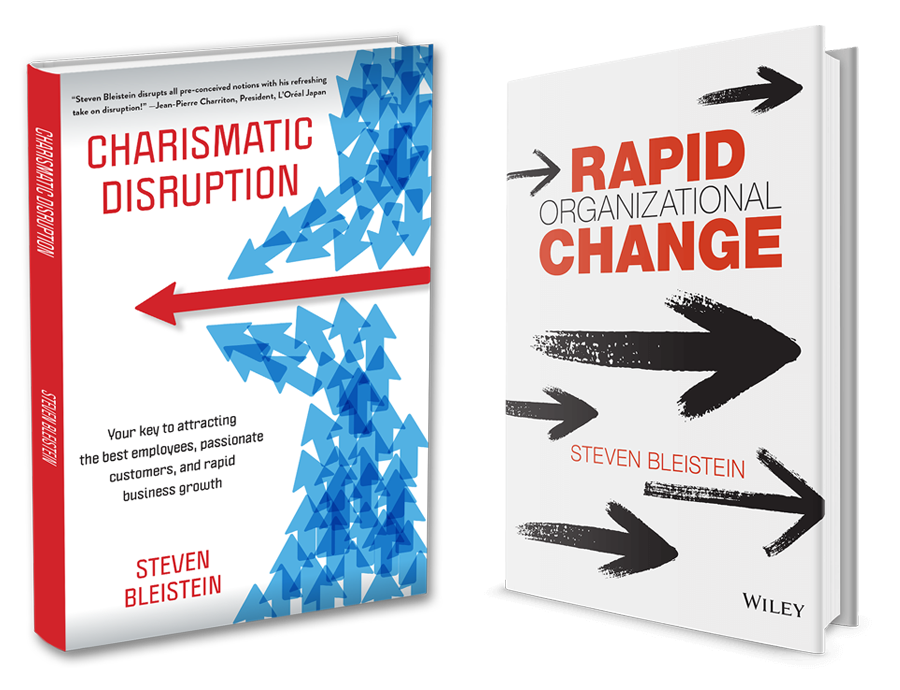[:en]CEOs often ask me how best to lead dramatic, strategic change knowing full well the kind of concerns, resistance, and doubt that such change can evoke in some staff. Below I list some of what advise.
- It is success that prompts need for dramatic strategic change, rarely failure. The CEO of a Japanese company seeking to radical transformation of his company’s long-held business model to one that will disrupt the industry and likely cause more than dismay among long-term customers asked me, “How can I explain the strategy we have had up to now had been wrong?” My answer? “You don’t have to. Your premise is wrong!” The need and desire for change was prompted by the company’s success. The strategy up to that point had worked! However, the old strategy no longer made sense to take the business to the next level, nor to adequately address new opportunities in the industry which had not existed before. Make sure your employees know that it is their success that prompts the need for change, not any failure, shortcoming, or mistake.
- Catering to your vanguard trumps appeasing your skeptics. In any dramatic change in an organization, some of your staff will be your vanguard, and on board from the start. Some will be naysayers, and will never be convinced no matter what you say or do. Most will be on the fence waiting to see which way the wind blows, either leaning skeptical but willing to be convinced or leaning cautiously optimistic hoping to see good results. The naysayers might be the most vocal, but ignore them. Appeasing the naysayers in hope to change their views only dampens your vanguard’s belief in your resolve. Some of your vanguard—the very people you want to retain—might even quit in frustration! People on the fence will begin to lean more skeptical. Ignore your naysayers and move forward fast, and you will ignite the enthusiasm of your vanguard. Those on the fence who are leaning optimistic will likely join them, because energy and enthusiasm is contagious. The leaning skeptical will see the way the wind is blowing and begin to lean optimistic. Some of the ardent naysayers will ultimately leave company of their own accord. Don’t hesitate to fire the rest after all else has been tried and failed.
- Dissent is a mark of a thinking adult. Never worry about people who disagree. It is alright that someone would have taken the business in a different direction from the one you chose, as long as they will back you in your decision. When they are leader, they can decide. It is alright for someone to believe there is a better way to achieve agreed upon ends, as long as they voice their ideas so everyone can consider them. Who knows? They might be right! Thinking adults will come to their own conclusions in their own time. Some will agree with your bold strategic change right away. Others will need the time to be convinced. I find few business practices more offensive than evangelism, where a leader attempts to convert everyone at the same time with fervor. Few things in business are more insulting than employing normative pressure of a crowd to evoke what is often feigned enthusiasm for an idea that many are still trying to grasp. If you want people to be on board with you and not just your idea, you need to make room for atheists in the tent.
- The right strategy takes you to the business you want, not to the business you think you can reasonably expect to have. The putative “right” strategy is an illusory concept. In most cases, a business has multiple options for strategy, most of which are good. At one client company of mine, the CEO asked me how to respond to questions about a strategy of selling directly to end-customers when the company has outstanding opportunity in expanding selling through distributors. The answer is only that both strategies are good, and the company could be successful at either, but not both. The direct-selling strategy a choice, not an imperative.
- Contingencies for when your assumptions are wrong trump analysis for why your assumptions must be right. If you want to be convincing about soundness of your strategy, no matter how bold, talk about all the reasons you might be wrong and what you plan to do if that turns out to be the case. No strategic plan ever survives the first encounter with the market. Whether members of a board or staff in your company, it is the leader who has eyes wide-open to risk, and is prepared to take action to succeed, come what may, who inspires confidence. It is only the leader who expounds endlessly on the righteousness of a single playbook based on reams of meticulously analyzed data who others will doubt can deliver when a faulty assumption becomes apparent and the playbook no longer applies. It is contingencies that make a strategy robust.
- The best strategies require no slide presentation to explain. If your staff are unable to grasp your strategy with a few succinct sentences from you, no slide presentation will make it any easier to understand. Note here that I say “gasp,” not agree. Understanding and agreement are not the same, and as I mention above, dissent is a mark of a thinking adult.
- Bold strategy polarizes, at least at first. Weak strategy evokes only mild assent disguised as team unity. If a strategy you propose as leader causes people in your company to jump up and down shouting, “Well it’s about time!” and while others rail that this is the end of the business, then you are likely on to something good. It is only the strategy that everyone agrees is reasonable that is unlikely to produce anything other than mediocre results.
These are just some of the principles in my manifest for leading bold strategic change. What are yours?[:ja]組織において劇的、戦略的な変革を実行すれば、それに対する懸念、反対意見や疑問を表明する社員が出てくるのは普通のことです。では、そのような状態になることを十分承知の上でその変革を導く最良の方法は何でしょうか。これは私もCEOの方々からよく受ける質問ですので、私の答えをいくつかここで紹介します。
- 劇的、戦略的な改革が必要となってくるその理由は成功であり、失敗のせいということはほとんどない。ある日本の企業は長年使ってきたビジネスモデルを変更し、業界を混乱に陥れ、昔からの顧客を落胆させる可能性も高いようなビジネスモデルにすることを考えていました。そこのCEOから受けた質問は、「これまでのビジネスモデルが間違っていた、ということをどのようにして説明すればよいか。」というものでした。私はこう答えました。「そのような説明をする必要はありません。間違っていた、という前提自体がおかしいと思います。」変革が必要だ、そして変革を行うべきだ、という結論に至ったのは、会社が上手くいっていたからなのです。それまで採用されていた戦略が機能していたということです。しかし古い戦略を使い続けては、ビジネスを次のステージに成長させ、新規の業界で新しいチャンスをモノにすることはできません。社員たちには改革が必要となったのは会社がうまくいっているからであって、失敗や欠点などのせいではないことをクリアにしましょう。
- 改革に懐疑的な人々をなだめるより、改革をリードする人たちをサポートするの方がずっと大切である。企業で劇的な変革を行う際、社員の中には最初からあなたに賛同し、先駆者となってくれる人が出てくると思います。一方で、改革に反対し、あなたが何を言おうとも納得してくれないような社員もいるでしょう。そして残りの殆どは、懐疑的ではあるけれども納得の行く内容であれば賛成側に回る、あるいは改革を楽観視しつつも少々慎重になっているといった人々で、彼らはとりあえず成り行きを見守ろうとすると思います。中でも特に意見を主張するのは反対派でしょうが、彼らは無視して大丈夫です。そのような社員の意見を変えようとして頑張っても、それは賛成派の社員があなたの決意を疑うような結果をもたらすだけです。中には不満を感じて辞めてしまう人まで出てくる可能性もあります。改革において先駆者となってくれるような社員こそ守るべきであるのに。様子見をしていた社員も、だんだん懐疑的になっていくでしょう。とにかく反対派の社員に注意を払ったりなどせず改革を早く進めれば、賛成派の社員たちの熱意がどんどん高まるでしょう。また熱意やエネルギーといったものは周りに伝わるものですから、楽観的な目で改革を横から見ていた社員も賛成側に加わり始めると思います。懐疑的だった中立の社員はといえば、そのような風向きを見てだんだん楽観的な考え方をするようになっていくことも想像されます。頑固な反対派はというと、最終的には自分から会社を去ることになるでしょう。色々やってもどうしようもなかった残りの社員は、躊躇することなく解雇して構いません。
- しっかりした大人同士の間での意見の相違はあって当たり前である。あなたに反対する人々のことを気にすることはありません。自分であれば違うやり方をする、という人もでてくるでしょうが、それでもあなたの決定をサポートしてくれさえすれば問題はありません。リーダーは決定権を持っているのです。目的を達成するためにはもっと良い方法がある筈だと信じる人がいたとしても、彼らが自分のアイディアをシェアし全員で検討するチャンスがあるのなら大丈夫です。そのアイディアが良いものである可能性もあります。大人であればそれぞれ自分の考えがあります。すぐにあなたの大胆な戦略的変革プランに賛成してくれる人もいるでしょうし、納得するのに時間が必要な人もいるでしょう。熱意を持ってとにかく全社員を一気に自分側につけようとするリーダーを見かけることがありますが、それはビジネスプラクティスとして酷いやり方だと私は考えます。団体で圧力をかけて、まだクリアにされていないような内容のアイディアに対しての情熱を持たせようとするなど、屈辱的なやり方もないと思います。周りの人々に、ご自分のアイディアだけにではなく、あなた自身に見方についてもらいたいと考えていらっしゃるのであれば、何派にも属さない無神論者がいてもそれを受け入れてください。
- 良い戦略はあなたの欲するような方向にビジネスを導いてくれるものであり、常識的に達成できると思われるようなことを達するためのものではない。推定的な「正しい」戦略とは架空の概念に過ぎません。大抵の場合、戦略のオプションは多数存在し、またその殆どは良い戦略です。あるクライアントのCEOにこのような質問をされたことがあります。「うちの社では今、小売業者を通して販売ルートを拡大するという素晴らしいチャンスがあるのですが、ユーザーに直接販売を行う戦略についても検討するという話が上がっています。どうすれば良いでしょう。」どちらの戦略も悪くありません。どちらをとってもうまく行く可能性はあるでしょう。しかし、両方の戦略を採用しては成功するとは思えません。直接販売の戦略の方はあくまでもオプションであり、必要なものではありません。
- 仮定事項が間違っていた時の為の対処方法を用意しておく事は、仮定事項の正当性を立証する為の分析を行う事よりずっと大切である。ご自分の戦略がたとえどれだけ大胆なものであってもとにかくしっかりしているということを証明したいのであれば、その戦略が間違っている可能性がある理由を全部挙げ、間違っていた場合の対処法を説明して下さい。市場で初めて実行した時に想定通り運ぶ戦略プランなどありません。役員であれ社員であれ、リスクを常に意識し、何があろうが成功に導く為のアクションをとる準備ができているリーダーこそが、自信を呼び起こしてくれる存在となるのです。逆にやたら綿密に分析されたデータをもとに決められたやり方の正当性をとにかく説明するようなリーダーは、仮定事項が間違っており、その決められたやり方が通用しなくなった時に、周りからの信頼を失ってしまいます。戦略を堅固なものにしてくれるのは、不測の事態への対処方法なのです。
- 最良の戦略を説明するのにスライドによるプレゼンテーションなど必要ない。あなたが数文で簡潔に説明してもスタッフに理解してもらえないような戦略は、たとえスライドを使って説明しても無駄です。私がここで言っているのは「理解」してもらうということで、賛同してもらうことではありません。理解と賛同は別物であり、先にも述べたとおり、しっかりした大人同士の話し合いの場では反対意見が出てくるのも当然です。
- 大胆な戦略であれば、少なくとも最初は意見が割れるものである。しっかりしていない戦略であれば、程々の同意を得ることができ、チームが一つになっているという雰囲気の印象さえ与えます。しかし、もしあなたがリーダーとして戦略を提案した時に、「遅すぎるくらいだ!」などと叫んで興奮する人がいる一方で、これでこの会社も終わりだ、などと落ち込む人がいたりすれば、あなたの戦略が素晴らしいものである可能性は高いと思います。逆に全員が適当であると賛成するような戦略が良い結果を出せる可能性は低いものです。
以上、大胆な戦略的変革を進める際に私が大切だと感じていることのいくつかを挙げてみました。あなたは改革においてどのようなことが重要だと考えていらっしゃいますか。[:]


